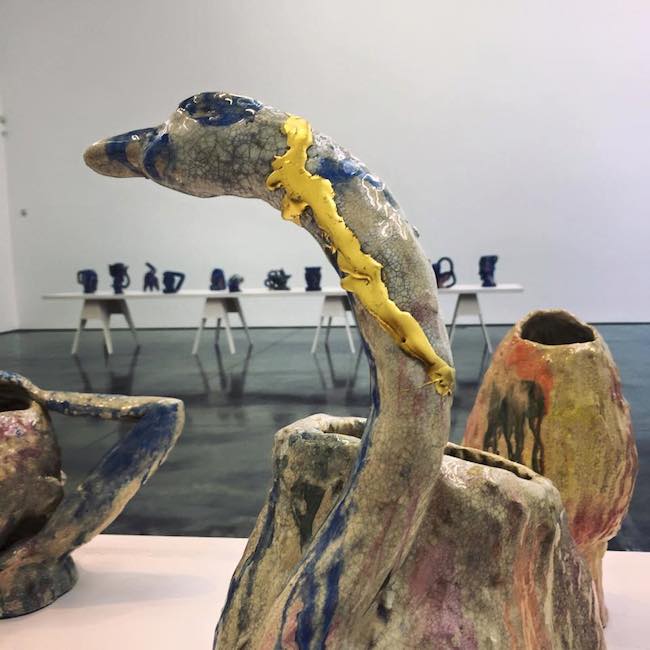There is something of an irony about the work in Andrew Lord’s new exhibition at Barbara Gladstone Gallery, Andrew Lord: at sunset, with snow falling, by starlight (New York, May 1-30, 2015). Lord has always been unique, a loner. His approach to clay gives an aura of craftlessness (but his works are actually superbly and carefully constructed). That appearance, the seeming casualness with which he moves the clay and the “sloppy” glazing has irked the ceramics community for five decades while at the same time intriguing the art world.
Above image: Installation view of Andrew Lord: at sunset, with snow falling, by starlight. Photograph by Leslie Ferrin.


Photographs by Leslie Ferrin.
I met him in London when he had his first solo show in 1973. The work (since I had been weaned up until that point on Coper, Rie, Duckworth and Cardew) was informel, a shock. It took years and a lively correspondence with the artist to get an appreciation of his vision, a courageous and solitary one at one at the time. I have been a fan of his art ever since.


Lord installation views at the Gladstone Gallery.
However, now his “look” is everywhere, Lord Pots and Lord Sculptures abound throughout New York and beyond. This will change the critical context in which he is reviewed for the next few years. For the first time Lord is now competing in a genre he pioneered and in many ways founded. The exhibition of three works, each on a table, is handsome collectively, less so from object to object, but in Lord’s aesthetic that has never been an issue. Do visit this exhibition.
Ken Johnson of the New York Times reviews his most recent show, drawing a comparison between Lord’s work and works by Paul Gauguin:

Photograph by Leslie Ferrin.
“At once bracingly ugly and sensuously beautiful, the recent ceramic sculptures by the British artist Andrew Lord look as if they’d been made by a clumsy but aesthetically sensitive giant. Displayed on three white tables are pitchers in the form of human heads with handles, variously shaped vases and constructions resembling maquettes for fountains populated by little nude female figures. Each retains the marks of its vigorous manual formation in the gouging, impressing and squeezing of the clay. They are glazed in Abstract Expressionist style with the colors brushed, poured and drizzled, creating lively marriages of sculptural form and painterly surface.
“While they seem to be products of primal, intuitive impulses, the sculptures also have a sophisticated, Postmodernist dimension: All are variations on ceramic works made by Paul Gauguin in the late 1880s and early ’90s, which have been an inspiration for Mr. Lord since the 1970s. In addition, here and there you see irregular lines of gold-leafed glue — repairs of broken parts in the Japanese tradition of wabi-sabi.
“Mr. Lord created these works in his New Mexico studio with the idea that each set would be glazed to represent different conditions of light. The 13 pieces of “by starlight, Carson mesa (Gauguin)” are mostly dark blue. The 13 in “at sunset” sport bright yellows and tomato-soup reds. In the 15-piece “with snow falling,” pale colors are washed over predominantly off-white glazes, suggesting the haze of wintry precipitation. Contemporary clay sculpture doesn’t get much better than this.”
Garth Clark is the Chief Editor of CFile
Any thoughts about this post? Share yours in the comment box below.

Installation view from the Gladstone Gallery.

Photograph by Leslie Ferrin.

Photograph by Leslie Ferrin.

Installation view from the Gladstone Gallery.

Installation view of Andrew Lord. Photograph by Leslie Ferrin.

Aesthetic relativism and the pursuit of the scatalogical is the demise of art in the late 20th Century. Decipline, design and execution is quickly becoming a thing of the past. In short not impressed .
I agree Luis
Beautiful installation.
Why this need by the artworld to condescend to ceramics and particularly pottery, by conflating it with sculpture? Lord’s art is ceramics in its material and pottery in its context and if at all necessary, it could be simply called sculptural ceramics, which is the true category under which it operates.
Ceramic Sculpture” is a political category while “Sculptural Ceramics” is a conceptual category.
How well said. Thank you. Never ending fight for approval by the art world.